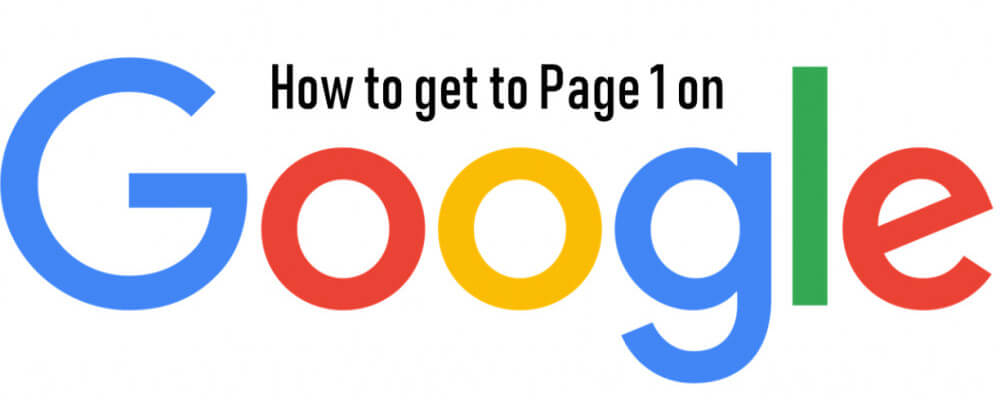Get Ranked on Google’s First Page.
Google is currently the most widely used search engine. That’s why we wrote a guide on how to get your website included on Google’s front page.
One of the most crucial things you can do for your business is to learn how to get your website on the first page of Google. After all, in today’s society, most people turn to Google when they need an answer to almost anything.
Google can be a terrific source for driving visitors to and increasing the revenue in your business from services, goods, and general assistance.
Working for the top position is well worth the effort, especially in light of the fact that traffic and click-through rate both sharply decline as one moves farther down the search results. There are various ways to stand out.

It’s definitely not lonely at the top, according to new research from the online ad network “Chitika.” The study found that the top listing in Google’s organic search results receives 33% of visitors compared to the second position’s 18% and that the traffic only gets worse from there.
Know Your Domain Authority.
Most domain authority ratings fall within the 40 and 60 percent range, roughly speaking, but keep in mind that this range is intended for website owners who have spent some time developing links, authority, and traffic on their sites. New websites typically receive nothing near the 40 to 60 percent range. Their Domain Authority scores are lower. This ranking was created by “MOZ,” which forecasts a site’s position on each search engine results page (SERP).
According to Moz, domain authority is determined by more than 40 criteria. So when it comes to boosting your website’s Google PageRank, building up your Domain Authority (DA) is not as simple and quick as doing so with other metrics.
Domain Authority for SEO.
As long as Moz uses a variety of important parameters in its algorithm, it would be best if you considered Domain Authority (DA) enhancement as a viable SEO technique.
A key component of your SEO strategies should be increasing your Domain Authority (DA).
It’s important to understand how authoritative your website is. It determines the entirety of your SEO plan. Which keywords will provide the greatest traffic to your site depends on your domain’s authority in Google’s eyes.
If your site has high authority, you can target challenging keywords that often generate more traffic; but, if your domain lacks SEO strength, you should target keywords that generate less traffic but are simpler for a weak domain to rank for.
Determine Your Domain Authority
- Visit Moz.com Link explorer and create a free account.
- Enter your site URL in the explorer.
- Note down the domain authority
Use a Keyword Search Tool.
You will have found out what your Domain Authority is and whether you should be looking for the more challenging or the simpler keywords. If you have just started you will be going for the “low hanging fruit” or simpler keywords to work on.
You may want to look at a basic tutorial on what is a “Keyword Research Tool” I wrote some time ago, by clicking on the blue link. Or we can just dive in here.
Finding the appropriate terms to use in your content so that Google and the reader may locate the solution to their query is known as keyword research. The reader can find the right material for their query if we employ the right keywords, which will help us rank easily and attract targeted visitors.
Different Keyword Tools.
There are many free and paid tools available to assist you with this procedure. Some of these are SEMrush, Moz, Ahrefs, and Soovie but let’s look at one I personally use. Jaaxy. Click the blue link, Jaaxy, to start a free trial of this program. There is no need to enter your credit card information.
Then, choose 15 to 20 keywords that customers might use to search for your goods or services. For instance, “Garden Hoses.” Your keywords may therefore be “What is the best garden hose”, “What is the most durable garden hose” etc.

How Does Jaaxy Work?
The three main headings we should concern ourselves with are Avg, Traffic, and QSR.
AVG is the average traffic these phrases or keywords get. In this case, what is the best garden hose?
Traffic is the monthly traffic these phrases or keywords get.
QSR is the competition from other websites using the same keywords or phrases. We are looking for the most amount of traffic and the least amount of competition.
Find Out Readers Search Intent.
We should have narrowed down 5 strong keywords and we need to find out the search intent behind them. Search intent is really just the intention of the reader.
Are they looking for Informational intent, that is someone looking for information? Example; What is the best garden hose for small gardens.
Or navigational intent, someone who is looking for a particular website. They will type in the website URL.
Perhaps they are looking to buy something. Whether it’s web hosting, learning English, or fishing rods they are after a transaction and displaying buyer intent.
Results.
Videos and blog posts are the best formats for keywords with an informational intent, whereas product/service pages and landing pages are the best for keywords with transactional intent.
Navigational intent keywords are only effective for the website or business that users are searching for.
Tell Google What Keywords you are Using.
When Google crawls the web, it ranks the millions of pages that are already there and stores them in an index. When a user conducts a search, Google can then search through its better-organized index to produce important and relevant results quickly.
Making it as simple as you can for Google to scan, index, and retrieve your site is thus a crucial step in getting your website to appear on the first page of Google. Put keywords in the following areas to achieve this.
Meta title. Your website’s pages and blog posts each have a meta title. This title not only displays as the title of that page’s listing in search results but also appears at the top of your page in the form of a header.
Meta description. In Google’s search results, the brief sentence that appears below the title is known as the meta description.
URL. By including keywords in your URL, you’ll make it easier for Google to understand what your page is about. Additionally, the URL can be seen in search results after the title and meta description. Users find a clear URL that matches the page’s title more appealing and trustworthy, and it is more suited for first-page listings.
ALT Tags. Images can only be viewed by Google if a text substitute is provided. If your alt tag contains keywords, Google will be able to determine that the page is more relevant and will be more inclined to list you on the first page of search results.
Get Writing.
It’s time to start writing the content now that you know what keywords to target and what kind of material to develop for them.
One of these two, informational or transactional intent, is probably the type of content you will be targeting.
The same SEO optimization guidelines apply to both sorts of content, whether it be a product or service page or a blog post.
Your URL should never be too long and should always contain the core term you are targeting. Your major keywords should be in the post title, which should be no more than 5 – 6 words long.
Google is starting to like the longer more informative posts but they do not like keyword stuffing which will result in you moving a long way from page 1.
Main URL headings by default will be in H1, and h2 should be used for subheadings throughout your content. And use images like infographics and videos to easily get your message across. Google is looking for a friendly and easy user experience (UX) for people on your website.
Write For Human Beings.
The most crucial area to add the keywords you’re seeking to rank for on your website is in the body of the text. To be effective, these keywords must be naturally introduced rather than stuffing them in. In fact, Google can now recognize keyword stuffing and will kick you off the first page of its results if it finds you have done just that.
The secret to ranking on the first page of Google is to offer informative, dependable, helpful, and easy-to-read material that will keep your target audience on your pages and returning for more. Additionally, it is free and simple to speak with others about the knowledge you already possess. Just keep in mind that your page must offer the information—not just the keywords—that visitors are seeking when they enter that search into Google.
Get Mobile Friendly.
Nowadays, consumers use their phones and tablets more frequently than their laptops and computers, and most local searches are made on mobile devices. Google thus prefers webpages that are compatible with mobile devices. In actuality, mobile-first indexing is now used to index all websites.
The best websites are responsive because they can function on any size screen while adjusting to it. If you don’t have a responsive website, you can still make changes to your site to give mobile users the best possible experience.
Read more here about “how you can speed up a website load time.”
Use Internal and External links.
Internal Links. Internal links are those that lead to pages within your website. Although they are the easiest to obtain, many people fail to realize this. Utilizing internal linkages has two advantages. In addition to helping your pages rise in the Google rankings, internal links also keep people on your site longer, which is another element in the Google rankings.
External Links and Back Links. External links are links to other sites and are used to validate the material you have posted. You may be quoting a source or drilling down on some external information.
Back Links.
And lastly, backlinks which are like votes or shows of support. The more votes you have, the higher your site ranks on google. But they are also the hardest to get and you need a plan in place to get them. Whether it’s by utilizing Google or H.A.R.O ( help a reporter out) to optimize your chances, you do need to manage to get them.
Your backlinks or links pointing to your website let Google know that other websites respect and acknowledge the authority of your website.
It’s crucial to remember that backlinks from trustworthy websites are the ones that can raise your page’s ranks.
They shouldn’t contain harmful or spammy links. It is crucial to maintain the same URL structure and never change it. Don’t forget to redirect those outdated URLs to your new ones if changing any of your URLs is unavoidable.
Final Thoughts.
It requires a lot of consistent hard work to rank on Google these days but the rewards make it all worthwhile. Writing regularly about your industry and business will require you to stay in tune with what your target audience wants.
Optimizing and updating your content is all part of the effort you need to do to stay ahead of others.
And if your website looks good and offers a superior UX then your readers, and Google customers will find it easy to consume the content. And this means they are more likely to stay on the page and read it till the end increasing your chances of making a sale.
Any or all links on this site may be affiliate links, and if you purchase something through those links I will make a small commission on them.
There will be no extra cost to you and at times due to my affiliation, you could actually save money.



